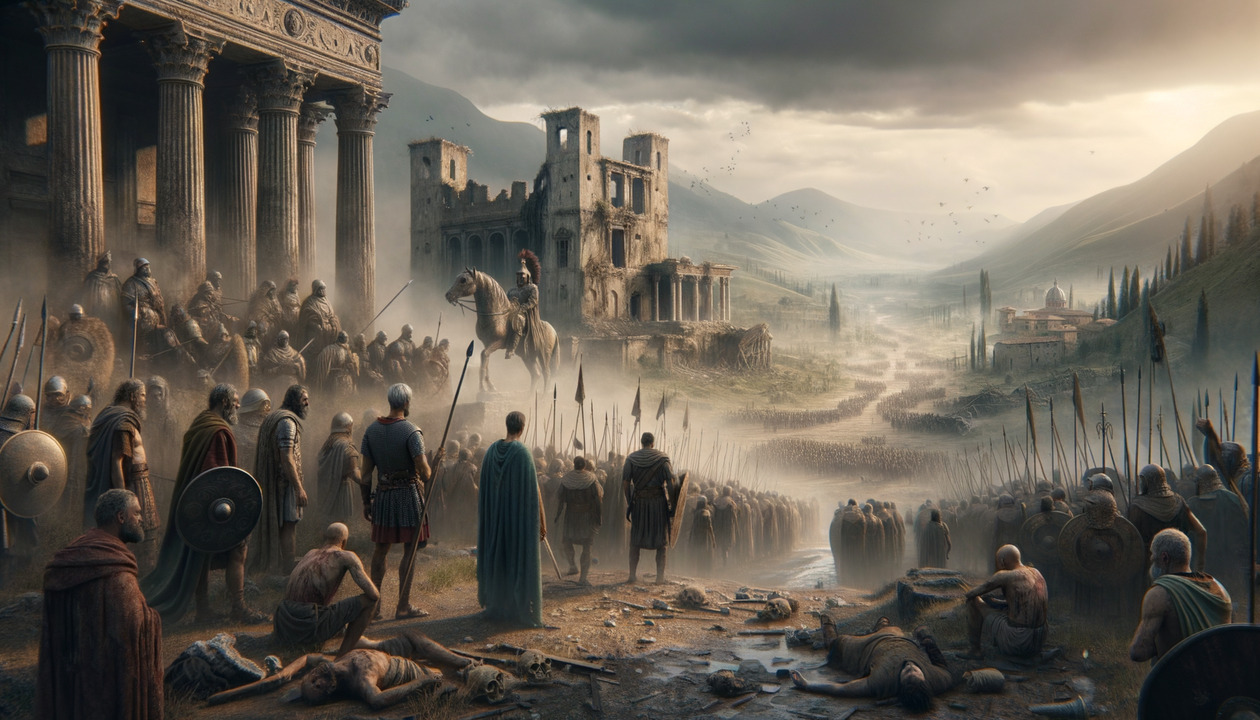
Retreat from Italy (452 AD)
Following the encounter with Pope Leo, and facing disease and famine, Attila retreated from Italy. This decision showed his pragmatic approach when confronted with tactical challenges.
Attila the Hun's Retreat from Italy in 452 AD
In the annals of history, few leaders have commanded the fear and respect that Attila the Hun did. Known as the "Scourge of God" to the Romans, Attila's military campaigns left a trail of destruction across Europe. However, even the most formidable of conquerors must occasionally weigh pragmatism over ambition. Such was the case in 452 AD, during Attila's campaign in Italy.
The Italian Campaign: A March of Devastation
By 452 AD, Attila had already established himself as a formidable force. His campaign into Italy was another step in his quest to expand the Hunnic Empire. Attila's forces crossed into Italy, leaving a path of devastation as they pushed southward. City after city fell to the might of the Huns, with aqueducts destroyed and populations scattered.
Rome itself, weary and struggling from internal strife and repeated invasions, seemed vulnerable to Attila's onslaught. The year prior had seen the sack of the city by the Vandals, and now the specter of the Huns loomed ominously.
The Encounter with Pope Leo I
As Attila's clutches tightened, an unexpected diplomatic mission sought to halt his progress. Pope Leo I, also known as Leo the Great, took the unprecedented step of meeting Attila in person. The details of their encounter are shrouded in a mix of history and legend, but it is widely recognized as a pivotal moment.
Accounts vary as to what transpired during this encounter. Some suggest that the pontiff, through words of negotiation or divine intervention, persuaded Attila to abandon his siege and retreat. Others hint at a display of divine warning that turned Attila away. Regardless of the method, the outcome was certain: Attila's forces began their withdrawal.
Tactical Challenges: Disease and Famine
Beyond the diplomatic prowess of Pope Leo I, Attila faced significant logistical challenges during his Italian campaign. As his troops advanced, Italy's late summer rains had led to rampant disease spreading among the Hunnic ranks. Coupled with this, the fertile lands of Italy had been plundered extensively, leaving few resources for the invading forces. Famine loomed large, crippling their capacity to maintain an extended siege or continue their conquest.
These adversities would have given even the fiercest warriors pause. For Attila, a leader known for his sagacious military strategy, the decision to retreat was a clear example of his pragmatic leadership.
Strategic Respite or Tactical Necessity?
The retreat of 452 AD illustrated Attila's astuteness; he understood that the long-term sustainability of his forces was paramount. Instead of risking the complete depletion of his army in a prolonged and potentially disastrous Italian campaign, he opted for a strategic withdrawal.
Historians suggest that Attila intended to regroup and possibly return to Italy after resolving the issues faced by his forces. However, fate had other plans. Attila would never return to Rome. His death in 453 AD curtailed any future campaigns, leaving the "what-ifs" of history to the imagination.
Conclusion: A Lesson in Leadership
Attila's retreat from Italy stands as a testament to his ability to adapt and recognize strategic imperatives. It highlights an often-overlooked aspect of his leadership: the capacity to acknowledge and address tactical constraints, even in the face of potential glory.
Thus, in 452 AD, amidst the backdrop of diplomatic encounters and logistical quandaries, Attila the Hun chose pragmatism, leaving a legacy that transcends mere conquest and pillage. His decision to retreat was not one of defeat but of strategic foresight, reshaping the narrative of the infamous Hunnic ruler.